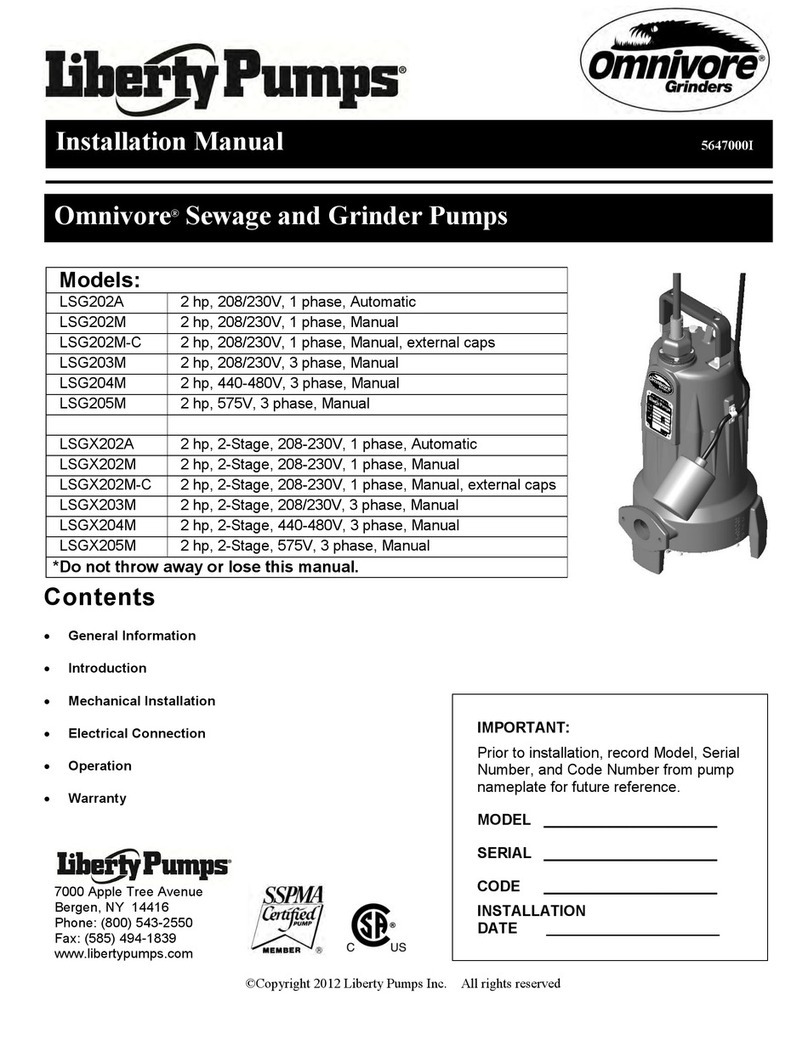
4428000G Copyright © Liberty Pumps, Inc. 2021
All rights reserved. 3 | EN
Do not use to pump flammable or explosive fluids such as
gasoline, fuel oil, kerosene, etc. Do not use in flammable and/
or explosive atmosphere. Sparks could ignite flammable
liquids.
Do not modify the pump/pump system in any way.
Modifications may affect seals, change the electrical loading
of the pump, or damage the pump and its components.
All pump/pump system installations shall be in compliance
with all applicable Federal, State, and Local codes and
ordinances.
Do not allow children to play with the pump system.
Do not allow any person who is unqualified to have contact
with this pump system. Any person who is unaware of the
dangers of this pump system, or has not read this manual, can
easily be injured by the pump system.
Wear adequate Personal Protective Equipment when working
on pumps or piping that have been exposed to wastewater.
Sump and sewage pumps often handle materials that can
transmit illness or disease upon contact with skin and other
tissues.
Do not remove any tags or labels from the pump or its cord.
Keep clear of suction and discharge openings. To prevent
injury, never insert fingers into pump while it is connected to a
power source.
Do not use this product with flammable, explosive, or
corrosive fluids. Do not use in a flammable and/or explosive
atmosphere as serious injury or death could result.
This product contains chemicals known to the State of
California to cause cancer and birth defects or other
reproductive harm. www.p65warnings.ca.gov.
Battery voltage can cause serious or fatal electrical shock.
Follow the battery manufacturer’s recommendations for
maintenance and safe use of battery before using charger.
Explosive gases develop during normal battery operation.
Keep battery in a well ventilated area, away from sparks and
open flames (such as pilot light). Never smoke in vicinity of
battery. Batteries generate flammable gases both charging
and discharging, which can explode or catch fire if ignited.
Battery acid is corrosive. Wear adequate Personal Protective
Equipment when working with the battery.
Never allow the battery DC terminals to touch each other. This
can cause severe burns and start a fire. For added safety,
protect the battery in provided battery box.
Only use 12 Volt lead acid batteries with this backup system.
Use of batteries with higher or lower output voltages can
damage the backup system, leak acid or explode.
A check valve is required in the primary sump pump
discharge pipe to prevent water from recirculating back into
the pit.
Pump clear water only with this pump.
Do not use pump system with mud, sand, cement,
hydrocarbons, grease, or chemicals. Pump and system
components can be damaged from these items causing
product malfunction or failure. Additionally, flooding can
occur if these items jam the impeller or piping.
Do not dispose of materials such as paint thinner or other
chemicals down drains. Doing so could chemically attack and
damage pump system components and cause product
malfunction or failure.
Do not use pumps with fluid over 104°F (40°C). Operating the
pump in fluid above this temperature can overheat the pump,
resulting in pump failure.
Do not run dry.
Be prepared for water to leak from the coupling or piping
when disassembling or cutting the discharge pipe. Protect
system components, tools, and supplies from getting wet. Dry
any work areas that get wet immediately.
Do not position the pump float directly under the inlet from
drain tile or in the direct path of any incoming water.
Do not expose pump or discharge to freezing temperatures.
Maximum vertical pumping distance is 18 feet (5.5 m) for 441
system; 21 feet (6.4 m) for 442 system.
If a Carbon Monoxide (CO) sensor is installed, it must be at
least 15 feet away from the battery charger in order to avoid
nuisance CO alarms. Refer to the CO detector’s installation
guidelines for more information.
Locate charger as far away from battery as DC cables permit.
Never place charger directly above battery being charged as
gases from battery will corrode and damage charger.
Never allow battery acid to drip on charger when reading
gravity or filling battery.
Do not operate charger if it has received a sharp blow, been
dropped, or otherwise damaged in any way; take it to a
qualified service professional.
Do not expose charger to rain, snow, or liquids.
Use charger only for charging a 12V lead acid battery.
12V marine-type deep cycle battery recommended (Group 27
or Group 31 AGM or Wet Cell compatible).
Never charge a frozen battery.
Never charge lithium ion batteries with charger.
A Group 27 battery will provide the same performance as a
Group 31 battery, but for a shorter length of time.
To protect battery box from chipping and gouging, do not let
the battery box sit on a concrete floor. Install the battery box
on a shelf or a protective pad (plywood, 2x4s, etc.).
Always install the battery box in a dry location that is
protected from flooding.
Use of a standard automobile battery with this charger is not
recommendedas anautomobilebattery may requirecharging
after only 1–2 hours of continuous use and the repeated
charging cycles may cause early plate failure in the battery.
Preparation
Before installation, read the following instructions carefully. Each
Liberty Pumps product is individually factory tested to ensure
proper performance. Closely following these instructions will
eliminate potential operating problems, assuring years of
trouble-free service.
The PC-Series includes a primary sump pump pre-assembled with
a DC powered battery back-up pump. An exploded view of
PC-Series combination systems for a 441 or 442 DC back-up pump
system is shown on next page.
RISK OF SERIOUS INJURY OR DEATH
BATTERY HAZARDS













































